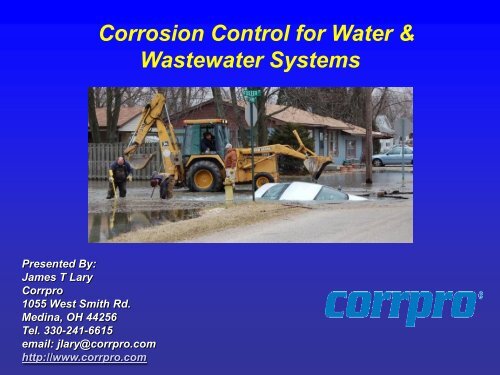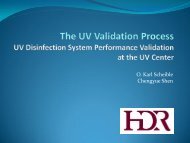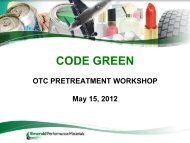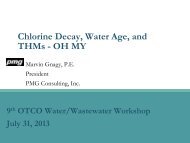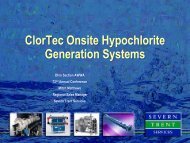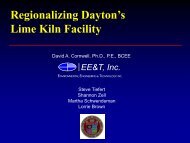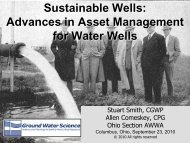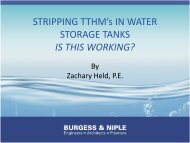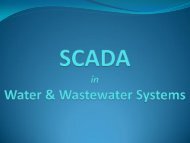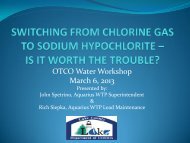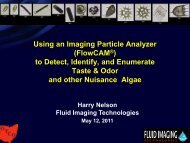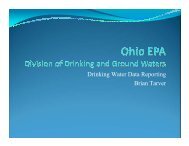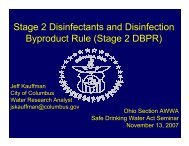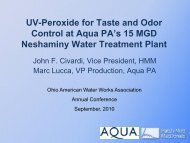Corrosion Control in Distribution Pipes - Ohiowater.org
Corrosion Control in Distribution Pipes - Ohiowater.org
Corrosion Control in Distribution Pipes - Ohiowater.org
- No tags were found...
You also want an ePaper? Increase the reach of your titles
YUMPU automatically turns print PDFs into web optimized ePapers that Google loves.
<strong>Corrosion</strong> <strong>Control</strong> for Water &Wastewater SystemsPresented By:James T LaryCorrpro1055 West Smith Rd.Med<strong>in</strong>a, OH 44256®Tel. 330-241-6615email: jlary@corrpro.comhttp://www.corrpro.com
Temporary Fix ?
<strong>Corrosion</strong>
<strong>Corrosion</strong> - A Natural ProcessIRON OXIDE REFINING MILLINGIRON,STEEL,PCCP CORROSION IRON OXIDE
<strong>Corrosion</strong> Cell on Buried Pip<strong>in</strong>gCathodic Area( + )Anodic Area( - )StructureCurrent Flow ThroughSoil or Water
<strong>Corrosion</strong> of Metallic Structure
Water(Electrolyte)Anodic Area(Corrodes)Metallic Return PathCurrentFlowCathodic Area(Protected)Tank Wall
History of Iron PipeCast Iron- Introduced to North America dur<strong>in</strong>g the 1800’s and<strong>in</strong>stalled till the 1970’s.- Early on, statically cast process produced a thickwalled, heavy pipe.- No longer produced <strong>in</strong> North America.Ductile Iron - Introduced <strong>in</strong> 1955 as an improvement tocast iron.- Centrifugal cast<strong>in</strong>g process produces a th<strong>in</strong>nerwalled, lighter pipe which is stronger andmore ductile than cast iron.
Cast (Grey) IronFailuresGraphitization leaves pipe brittle and weakened.
1.58 <strong>in</strong>.1.22 <strong>in</strong>.0.94 <strong>in</strong>.0.87 <strong>in</strong>.0.58 <strong>in</strong>.0.43 <strong>in</strong>.0.38 <strong>in</strong>.0.21 <strong>in</strong>.1908 1952 1957 1957 1976 1985 1991 LessCLD CL 150 CL 23 CL 22 CL 3 CL 50 CL 150 TolerancesCI CI 18/40 21/45 DI DI DICI CIActual size of AWWA Specification Thickness Reductions for 36-<strong>in</strong>ch DiameterCast and Ductile Iron Pipe - 1908 to Present (150 PSI Operat<strong>in</strong>g pressure)
Ductile IronPitt<strong>in</strong>g (concentrated)corrosion attack on ductile ironpipe.
Adverse Conditions for Metallic Pipe- High Chlorides- Low Soil/Water Resistivity- High Sulfates- Acidic Soils- Wet/Dry Fluctuations- Bimetallic Coupl<strong>in</strong>gs- Stray Current Interference
PRACTICAL GALVANIC SERIESMaterialPotential*Pure Magnesium -1.75Z<strong>in</strong>c -1.10Alum<strong>in</strong>um Alloy -1.00Cadmium -0.80Mild Steel (New) -0.70Mild Steel (Old) -0.50Cast/Ductile Iron -0.50Sta<strong>in</strong>less Steel -0.50 to + 0.10Copper, Brass, Bronze -0.20Gold +0.20Carbon, Graphite, Coke +0.30* Potentials With Respect to Saturated Cu-CuSO 4 Electrode
Coupl<strong>in</strong>g to Dissimilar MetalsMetallicConnectionCopper service (Cathode)- 300mVIron pipe (Anode)- 500mVCORRPROC O M P A N I E S I N C
Copper Service Connections
Anode Installation Prevents <strong>Corrosion</strong> onCopper Service L<strong>in</strong>eNon metallic orPolyethylene EncasedDuctile Iron Ma<strong>in</strong>Anode Connection to L<strong>in</strong>eAnode
Water Wells
Meter Vaults(Keep dry if possible)
Gate Valve <strong>Corrosion</strong>
Dissimilar Surface ConditionsPipe(Cathode)ThreadsBright Metal(Anode)Scratches(Anode)CORRPROC O M P A N I E S I N C
<strong>Corrosion</strong> Caused by DifferentialAerationAerated SoilOxygenAvailable(Cathode)PipeLowOxygen(Anode)CORRPROC O M P A N I E S I N C
Gas Pipel<strong>in</strong>e(-)Cathodic ProtectionRectifier(+)Anode GroundbedCurrent Discharge(<strong>Corrosion</strong>)Current Discharge(<strong>Corrosion</strong>)Water Pipel<strong>in</strong>eStray Current Due to Impressed Current CathodicProtection System
Impressed Current CP System on Oil/Gas L<strong>in</strong>es canCreate Stray Current Problem on Water L<strong>in</strong>es
PowerStationStray Current by DCOperated Transit SystemsPipel<strong>in</strong>eCurrent exit (Anode)Current entrance (Cathode)
Stray Current
Bond<strong>in</strong>g Across a Bell and Spigotor Slip-jo<strong>in</strong>tThermite brazedconnection coated withbitumous compoundCopper wire withdirect burial <strong>in</strong>sulation
Computerized Potential Logg<strong>in</strong>g SurveyTestStationBackpackComputer UnitCha<strong>in</strong>er/WireDispenser &CounterReferenceCellsBondedJo<strong>in</strong>tsPolywrapPipel<strong>in</strong>e
Potentials (millivolts)00+0500+1000+1500+2000+2500+3000+3500+4000+4500+5000+5500+6000+6500+7000+7500+8000+8500+9000+9501+0001+0501+1001+1501+2001+2501+3001+3501+4001+45Cha<strong>in</strong>age00+0500+1000+1500+2000+2500+3000+3500+4000+4500+5000+5500+6000+6500+7000+7500+8000+8500+9000+9501+0001+0501+1001+1501+2001+2501+3001+3501+4001+45CIS Survey8" Pipel<strong>in</strong>e Rivana River N to SClose Interval Survey Data-2500Cha<strong>in</strong>age-2500Potential (millivolts)-2000-2000-1500-1500-1000-1000-500-50000Close Interval DataInterrupted SurveyClose Interval DataPG/WFA Survey
Polyethylene Encasement- Follow manufacture’s and AWWA recommendations to<strong>in</strong>sure proper <strong>in</strong>stallation of polyethyleneencasement.- In extremely corrosive areas, additional methods (bond<strong>in</strong>gof jo<strong>in</strong>ts, cathodic protection, may be required).
Polyethylene Encasement of Ductile Iron Pipe-Follow DIPRA <strong>in</strong>stallation procedures-Clean pipe before <strong>in</strong>stall<strong>in</strong>g polywrap-Repair tears or damage to encasement-Engage an <strong>in</strong>spector to oversee <strong>in</strong>stallation
Galvanic Anode on PolyethyleneEncased Ductile Iron Pipe
PRACTICAL GALVANIC SERIESMaterialPotential*Pure Magnesium -1.75Z<strong>in</strong>c -1.10Alum<strong>in</strong>um Alloy -1.00Cadmium -0.80Mild Steel (New) -0.70Mild Steel (Old) -0.50Cast/Ductile Iron -0.50Sta<strong>in</strong>less Steel -0.50 to + 0.10Copper, Brass, Bronze -0.20Gold +0.20Carbon, Graphite, Coke +0.30* Potentials With Respect to Saturated Cu-CuSO 4 Electrode
Cathode(Protected)Anode
Galvanic AnodeStructureMagnesiumAnodeCurrent Flow
Thermit Weld to Pipe
Anode InstallationAugered holeGalvanic anodeConnection to pip<strong>in</strong>g
Access to Pipe
Number of Breaks25100 Breaks Prior to Cathodic Protection3 Breaks After Cathodic Protection2015101988 C.P. TotalsLength Protected = 12,780 feet5074 75 76 77 78 79 80 81 82 83 84 85 86 87 88 89 90 91 92 93 94 95YearBreak Records for Water Ma<strong>in</strong>s Cathodically Protected <strong>in</strong> 1988
Temporary Fix ?
Repair of Break ShouldInclude Anode InstallationIncompleteComplete
Water Leak Repair KitIncludes:Installation <strong>in</strong>structions.One day onsite technicalassistance.Cathodic protectioncomponents/connection materialssuitable for 10 repairs.
Lower Stress Area(Cathode)PipeThreaded BoltHigher Stress Area(Anode)Stress <strong>Corrosion</strong>Metallic Coupl<strong>in</strong>g
Cathodic Protection of Metallic Fitt<strong>in</strong>gAnode Lead Wire ConnectionPipeGalvanicAnodeMetallic Coupl<strong>in</strong>g
Anode Installed on Metallic Fitt<strong>in</strong>g
Meter Vaults(Keep dry if possible)
Bolt <strong>Corrosion</strong>(due to water/sludge)Bond CablesAnodeConnectionWater/SludgeMeter Vault <strong>Corrosion</strong>Meter Vault with Galvanic Anode
For New or Refurbished Tanks
Suspended Horizontal Anode SystemTop View DiagramSubmerged AnodeSupport SystemAutomatic Potential<strong>Control</strong> RectifierPressure Entrance Fitt<strong>in</strong>g
Horizontally Submerged Cathodic Protection System<strong>in</strong> Water Storage Tank
Annual Ma<strong>in</strong>tenance
<strong>Corrosion</strong> of Clarifier Center Well
Pump<strong>in</strong>g StationsCORRPROC O M P A N I E S I N C
Depleted & Refurbished CathodicProtection for Lift Stations
AC Mitigation
Investigative Structure (Exist<strong>in</strong>g)<strong>Corrosion</strong> Assessment• Review of General Characteristicsof Water System- Age- Material Type- Wall Thickness- Construction Practices• Review Break / Leak History• Field Survey- Soil Conditions (Resistivity,Moisture Content, ChemicalAnalysis)- Electrical Test• Data Analysis & Risk Management• Priority Index (Identification ofOpportunities to ReduceReplacement / Repair Costs)
Insituform
TrafficDisruptionsWater LossFireProtectionDamagesLegal &EnvironmentalClaims
QUESTIONS ?James T LaryCorrpro Companies, Inc.1090 Enterprise DriveMed<strong>in</strong>a, Ohio 44256330-723-5082 (x1215)email jlary@corrpro.com
Design Decision ModelFor Ductile Iron Pipe
Cathodic Protection of Metallic Fitt<strong>in</strong>gAnode Lead Wire ConnectionPipeGalvanicAnodeMetallic Coupl<strong>in</strong>g
Computerized Potential Logg<strong>in</strong>g SurveyTestStationBackpack ComputerUnitCha<strong>in</strong>er/WireDispenser & CounterReferenceCellsBonded Jo<strong>in</strong>tsPipel<strong>in</strong>e
<strong>Corrosion</strong> of Metallic Structure
Vertically Suspended High Silicon Cast IronAnode Str<strong>in</strong>g
SummaryReduc<strong>in</strong>g corrosion rates on exist<strong>in</strong>g water distributionpip<strong>in</strong>g will result <strong>in</strong> a reduction of the number of breaksand also extend the operational life.<strong>Corrosion</strong> control measures should be considereddur<strong>in</strong>g the design stage for any new metallic pip<strong>in</strong>gans storage tank <strong>in</strong>stallations.
Design Decision ModelFor Ductile Iron Pipe
AbovegroundStorage TankTest/AccessStationGrade3” PVC 20%Exposure10’TypicalAnode MaterialABOVEGROUND STORAGE TANKCATHODIC PROTECTIONAnode Tube
The estimated annual cost to repairwater pip<strong>in</strong>g breaks <strong>in</strong> NorthAmerica alone is estimated to be*:based on 250,000 breaks at a repair cost of $5,875.00 U.S.D. each
Budget Estimate for CompleteCathodic Protection System for1MMG Water Tank$12,000
New Pip<strong>in</strong>gPHASE I- Obta<strong>in</strong> draw<strong>in</strong>gs of proposed route- Conduct <strong>in</strong>dependent field <strong>in</strong>vestigation:a) Soil resistivity studyb) Identify foreign pipel<strong>in</strong>e cross<strong>in</strong>gd) Identify AC potential <strong>in</strong>fluencee) Collect soil samples (moisture content,chlorides, pH, sulfate ions concentration,conductivity)- Stray current <strong>in</strong>vestigation
<strong>Corrosion</strong> Protection DesignPhase IIPrepare Bid Quality Specifications for:- Coat<strong>in</strong>gs or Polyethylene Encasement- Test Stations (Monitor <strong>Corrosion</strong> Rates)- Bonded Jo<strong>in</strong>ts- Stray DC/AC Mitigation- Cathodic Protection- Comb<strong>in</strong>ation of Multiple Items- Review Submittals/Onsite Periodic Inspection
Lower Stress Area(Cathode)PipeThreaded BoltHigher Stress Area(Anode)Stress <strong>Corrosion</strong>Metallic Coupl<strong>in</strong>g
Transformer Rectifier
Insituform
Yard Pip<strong>in</strong>g Deep Anode GroundbedImpressed Current SystemAnode Junction BoxRectifier+ -ImpressedCurrent AnodesPip<strong>in</strong>g
Factory Installed Cathodic Protection Systems
Bi-Metallic <strong>Corrosion</strong> BetweenCarbon Steel Tank & Sta<strong>in</strong>less Steel Ladder
<strong>Corrosion</strong> <strong>Control</strong> for WaterSystem Pip<strong>in</strong>g Results <strong>in</strong> Reductionof Water LossPresented By:James T LaryCorrpro Companies, Inc1090 Enterprise Dr.Med<strong>in</strong>a, OH 44256Tel. 330-723-5082 (x1215)®email: jlary@corrpro.comhttp://www.corrpro.com
Repair of Break ShouldInclude Anode InstallationIncompleteComplete
Annual Cathodic Protection Survey
<strong>Corrosion</strong> <strong>Control</strong> for Water& Wastewater SystemsPresented By:James T LaryCorrpro Companies, Inc1090 Enterprise Dr.Med<strong>in</strong>a, OH 44256Tel. 330-723-5082 (x1215)®email: jlary@corrpro.comhttp://www.corrpro.com
<strong>Corrosion</strong> is the lead<strong>in</strong>g contributor to cast andductile iron water system breaks!
Bolt & Nut <strong>Corrosion</strong>
Inspection of CP System
Basic <strong>Corrosion</strong> CellGround SurfaceBuried PipeAnode-600mVCathode-550mV1) Anode2) Cathode3) Electrolyte4) Electrical ConnectionCORRPROC O M P A N I E S I N C
Structures- Pip<strong>in</strong>g (<strong>Distribution</strong>/Transmission)- Metallic Fitt<strong>in</strong>gs- Water Storage Tanks- Clarifier Units- Lift Stations
<strong>Corrosion</strong> Can be Def<strong>in</strong>ed as Either: PracticalTendency of a Metal to Revertto its Native State ScientificElectrochemical Degradationof Metal as a Result of a Reactionwith its Environment
History of Iron PipeCast Iron- Introduced to North America dur<strong>in</strong>g the 1800’s and<strong>in</strong>stalled till the 1970’s.- Early on, statically cast process produced a thickwalled, heavy pipe.- No longer produced <strong>in</strong> North America.Ductile Iron - Introduced <strong>in</strong> 1955 as an improvement tocast iron.- Centrifugal cast<strong>in</strong>g process produces a th<strong>in</strong>nerwalled, lighter pipe which is stronger andmore ductile than cast iron.
Dissimilar SoilsPavementSandy LoamClaySandy LoamCathodeAnodeCathodeDe-ic<strong>in</strong>g salts?Fertilizers?CORRPROC O M P A N I E S I N C
CARBON ROD(CATHODE)+0.30mVWIRE(CONDUCTOR)ZINC CASE(ANODE)-1.10mVMOIST PASTE(ELECTROLYTE)
Proper Handl<strong>in</strong>g & Installation ofPolyethylene Ductile Iron Pipe
<strong>Corrosion</strong> of iron when coupled to copper service l<strong>in</strong>e.
<strong>Corrosion</strong> Pitt<strong>in</strong>g
Dissimilar Surface ConditionsPipe(Cathode)ThreadsBright Metal(Anode)Scratches(Anode)CORRPROC O M P A N I E S I N C
<strong>Corrosion</strong> Caused by DifferentialAerationAerated SoilOxygenAvailable(Cathode)PipeLowOxygen(Anode)CORRPROC O M P A N I E S I N C
CP Benefits: - Triple life of coat<strong>in</strong>g- Reduce ma<strong>in</strong>tenance cost
Number of Breaks2094 Breaks Prior to Cathodic Protection1 Breaks After Cathodic Protection151993 C.P. TotalsLength Protected = 55,360 feet105074 75 76 77 78 79 80 81 82 83 84 85 86 87 88 89 90 91 92 93 94 95YearBreak Records for Water Ma<strong>in</strong>s Cathodically Protected <strong>in</strong> 1993
Coat<strong>in</strong>g Flaws (Holidays)
Number of Breaks2094 Breaks Prior to Cathodic Protection1 Breaks After Cathodic Protection151993 C.P. TotalsLength Protected = 55,360 feet105074 75 76 77 78 79 80 81 82 83 84 85 86 87 88 89 90 91 92 93 94 95YearBreak Records for Water Ma<strong>in</strong>s Cathodically Protected <strong>in</strong> 1993
TrafficDisruptionsWater LossFireProtectionDamagesLegal &EnvironmentalClaims
<strong>Corrosion</strong> on damaged polyethylene encased pipe.
<strong>Corrosion</strong> of pre-stressed concrete cyl<strong>in</strong>der pipe (P.C.C.P.).
Cathodic Protection Test StationTestStationMagnesiumAnodeStructure
Suspended Vertical Anode SystemSupport System Bolted toRoof for Bowl Anodes andReference ElectrodesTop View DiagramAutomatic Potential<strong>Control</strong> Rectifier
Cathodic Protection for Hot Water Tanks
<strong>Corrosion</strong>
PCCP Failure
PowerStationStray Current by DCOperated Transit SystemsPipel<strong>in</strong>eCurrent exit (Anode)Current entrance (Cathode)
Pre-stressed Concrete Cyl<strong>in</strong>der Pipe (PCCP)
Give Me a BreakFundamentals of Pipel<strong>in</strong>e <strong>Corrosion</strong>Presented By:James T LaryCorrpro1090 Enterprise Dr.Med<strong>in</strong>a, OH 44256®Tel. 330-723-5082 (x1215)email: jlary@corrpro.comhttp://www.corrpro.com
<strong>Corrosion</strong> <strong>Control</strong> & Cathodic Protectionof Water & Wastewater SystemsPresented By:James T LaryCorrpro1090 Enterprise Dr.Med<strong>in</strong>a, OH 44256®Tel. 330-723-5082 (x1215)email: jlary@corrpro.comhttp://www.corrpro.com
Pipel<strong>in</strong>e Inspection ReportInspector name_________ Date____ Address of pipel<strong>in</strong>e <strong>in</strong>spection ________________ Leak? Yes____ No____ File Number:_____________1) Type of Pipe: cast iron_____ ductile iron____ carbon steel___ copper______ carbon steel_____ non metallic_____ other____2) Diameter of pipe _____” Pipel<strong>in</strong>e Name_________ Service Type: Water____ Wastewater____ Estimated date of pipe <strong>in</strong>stallation______ Depth of pipe______’3) Type of Pipe: <strong>Distribution</strong>____ Transmission____ Service_____ Hydrant _____ Mechanical jo<strong>in</strong>t_____ Fasteners_____ Other____ Unknown____4) Type of Coat<strong>in</strong>g: Polyethylene Encased____ Shop applied coat<strong>in</strong>g___ No Coat<strong>in</strong>g____ Tape Wrap____ Unable to determ<strong>in</strong>e____5) External Pipe Condition: Very Good____ Good____ Poor____ comments:_______________________________________________________________________________________________________________________________________________________________________________________________________________6) Is corrosion pitt<strong>in</strong>g evident? ____ Yes ____ No Number of Pits______ Typical Size of Pits______ Quantity of pits:______7) Is graphitization evident (longitud<strong>in</strong>al or circumferential breaks) ____Yes ____ No8) Is the pipe <strong>in</strong>stalled <strong>in</strong> (check off appropriate items): Industrial area____ Residential area____ Rural area____ Near street or road ____Near creek or waterway ____ In reclaimed land___ Near oil or gas pipel<strong>in</strong>es____ Near high voltage l<strong>in</strong>es ____.8) Describe soil conditions where <strong>in</strong>spection occurred: wet____ dry____ clay soil ____ rocky soil____ c<strong>in</strong>ders ____ other____________________9) Where soil samples obta<strong>in</strong>ed, sealed and analyzed for chlorides, moisture content, pH, sulfides, resistivity? If yes results were: _____________________________10) Were previous repairs made on the pipel<strong>in</strong>e (leak clamps, etc) Yes____ No ____. Was new pipe <strong>in</strong>stalled____ Yes ____ No.11) Was a repair clamp <strong>in</strong>stalled on the pipe dur<strong>in</strong>g <strong>in</strong>spection ___ Yes ___ No12) Was a galvanic anode <strong>in</strong>stalled as part of the <strong>in</strong>spection process? ___ Yes ___ No, if yes size and quantity13) Please relay additional comments:_______________________________________________________________________________________________________________________________________________________________________________________________________________________________________________________________________________________________________________________________________________________________________________________________________________14) Plan of Action____________________________15) Insert digital photos below:
<strong>Corrosion</strong> Can be Def<strong>in</strong>ed as Either: PracticalTendency of a Metal to Revertto its Native State ScientificElectrochemical Degradationof Metal as a Result of a Reactionwith its Environment


